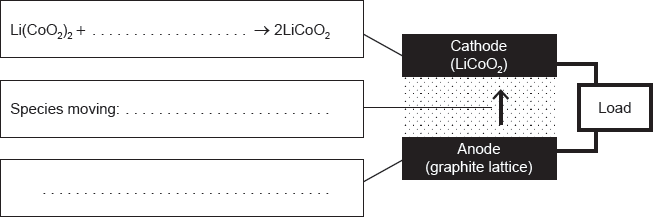| Date | May 2019 | Marks available | 3 | Reference code | 19M.3.hl.TZ2.19 |
| Level | HL | Paper | 3 | Time zone | TZ2 |
| Command term | Outline | Question number | 19 | Adapted from | N/A |
Question
Electricity can be generated in a variety of ways.
Outline how a microbial fuel cell produces an electric current from glucose.
C6H12O6 (aq) + 6O2 (g) → 6CO2 (g) + 6H2O (l)
The cell potential for the spontaneous reaction when standard magnesium and silver half-cells are connected is +3.17 V.
Determine the cell potential at 298 K when:
[Mg2+] = 0.0500 mol dm−3
[Ag+] = 0.100 mol dm−3
Use sections 1 and 2 of the data booklet.
Outline one difference between a primary and a secondary cell.
Markscheme
Any three of:
C6H12O6 (aq) + 6H2O (l) → 6CO2 (g) + 24H+ (aq) + 24e–
OR
electrons released by oxidation of glucose [✔]
enzymes «in bacteria» oxidize glucose
OR
«bacteria» transfer «released» electrons directly to anode [✔]
24H+ (aq) + 6O2 (g) + 24e– → 12H2O (l)
OR
electrons consumed by reduction of oxygen [✔]
PEM/membrane separates two half reactions
OR
PEM/membrane allows proton/H+ transfer from anode to cathode [✔]
electrons flow though external circuit [✔]
Note: Accept 4H+ (aq) + O2 (g) + 4e– → 2H2O (l).
«E = Eᶱ × lnQ»
lnQ = « » 1.61 [✔]
E = «3.17 V »3.15 «V» [✔]
Note: Award [2] for correct final answer.
Any one of:
Note: Accept “primary cannot be recharged AND “secondary can be recharged”.
Examiners report
The question on microbial cell invited varied responses. Half equations for the oxidation of glucose or reduction of oxygen were rarely written. PEM/membrane separates two half- reactions and allows proton transfer from anode to cathode was missed by most of the candidates.
The cell potential was correctly calculated by several candidates with some candidates managed an ECF mark for an error in the calculation. Unfortunately, the ln Q part was frequently wrong due to candidates forgetting to square the denominator.
Most candidates were able to state one difference between a primary and a secondary cell.



